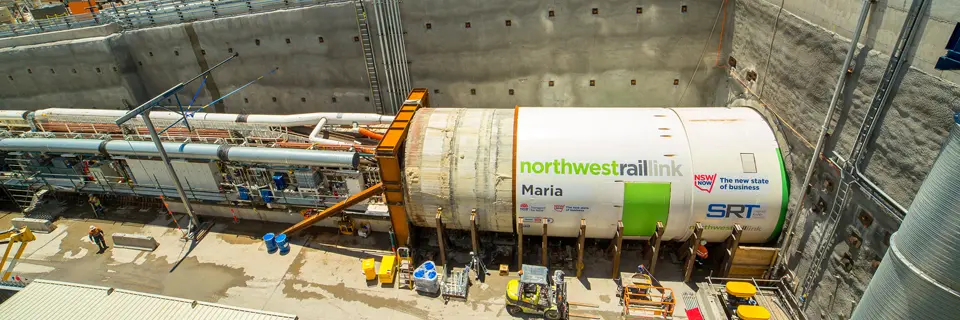All four tunnel boring machines now digging
15.01.2015

The fourth massive North West Rail Link tunnel boring machine has started digging and has been named ‘Maria’, after 19th century Aboriginal rights advocate Maria Lock. On major tunnelling projects around the world, underground workers look to Saint Barbara for protection and, because of that, machines that work underground are traditionally given female names. The North West Rail Link is the first transport project in Australian construction history to use four Tunnel Boring Machines (TBMs). After starting four months early in September last year, tunnelling is now well underway to deliver Australia’s longest railway tunnels, twin 15 kilometre tunnels from Bella Vista to Epping.
The fourth massive North West Rail Link tunnel boring machine has started digging and has been named ‘Maria’, after 19th century Aboriginal rights advocate Maria Lock. On major tunnelling projects around the world, underground workers look to Saint Barbara for protection and, because of that, machines that work underground are traditionally given female names.
The North West Rail Link is the first transport project in Australian construction history to use four Tunnel Boring Machines (TBMs). After starting four months early in September last year, tunnelling is now well underway to deliver Australia’s longest railway tunnels, twin 15 kilometre tunnels from Bella Vista to Epping.
The North West Rail Link is currently ahead of schedule with rapid transit rail services starting in the first half of 2019 with a train every four minutes for customers in the peak. So far, more than 278,000 tonnes of crushed rock has been excavated by the first three TBMs, as they make significant progress:
- TBM1 Elizabeth, named after colonial pioneer Elizabeth Rouse: has dug more than 1.8 kilometre of tunnel so far from Bella Vista.
- TBM2 Florence, named after Australia’s first female architect and engineer Florence Mary Taylor: more than 710 metres from Bella Vista.
- TBM3 Isabelle, named after Isabelle Andersen, aged four, to represent all the tunnel builders: more than 150 metres from Cherrybrook.
Ground level view of TBM4 Maria.
Along with TBM3 Isabelle, TBM4 Maria will dig six kilometres from Cherrybrook to Epping. She will dig an average of 120 metres a week, mostly through Sydney sandstone and shale.
TBM4 and Maria Lock
- TBM4 Maria, weighing 900 tonnes, was delivered to the Cherrybrook site in 18 shipping containers and 27 large pieces and was assembled by a crew of more than 70 workers.
- Three of the TBMs, including Maria, have been named in public competitions under the theme: Women who have made a positive contribution to life in Sydney.
- Maria Lock (c.1805-1878) was an Aboriginal landowner born near Richmond and the daughter of Yarramundi, Chief of the Richmond Tribes.
- The family belonged to the Boorooberongal clan of the Dharug people.
- In late 1814, Yarramundi's clan attended the inaugural annual conference hosted for Aborigines by Governor Lachlan Macquarie. At this time, Maria was admitted to the Native Institution, for tuition by William and Elizabeth Shelley.
- In 1819, Maria is said to have won first prize in the annual school exam ahead of 20 children from the Native Institution and 100 European students.
- In 1824 Maria married Robert Lock (1800-1854), a convict carpenter. The marriage was the first officially sanctioned union between a convict and an Aboriginal woman.
- At a time when women were not a political force and Aboriginal women even less so, Maria petitioned Governor Darling for her brother’s land entitlements and was the first female Aboriginal to be given a land grant, at Liverpool. The process took almost 20 years.
- Her grandson Jerome Lock served in World War 1 and is believed to be Australia's first Aboriginal Soldier.
Sources: Australian Dictionary of Biography (Australian National University) and Hawkesbury District Health Service.